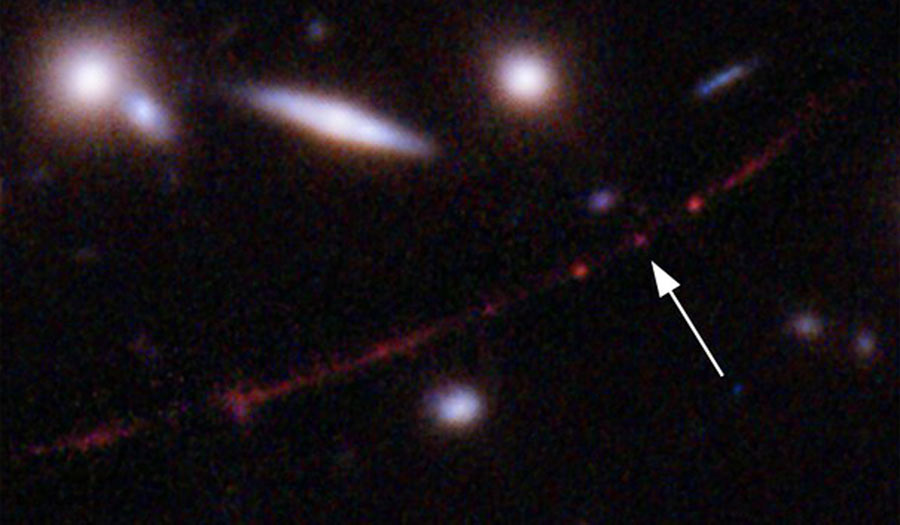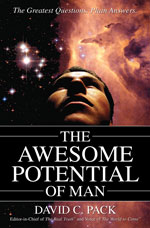 NASA, ESA, Brian Welch (JHU), Dan Coe (STScI); Image processing: NASA, ESA, Alyssa Pagan (STScI) via AP
NASA, ESA, Brian Welch (JHU), Dan Coe (STScI); Image processing: NASA, ESA, Alyssa Pagan (STScI) via AP
Article
Learn the why behind the headlines.
Subscribe to the Real Truth for FREE news and analysis.
Subscribe NowAstronomers have discovered the farthest star yet, a super-hot, super-bright giant that formed nearly 13 billion years ago at the dawn of the cosmos.
But this luminous blue star is long gone, so massive that it almost certainly exploded into bits just a few million years after emerging. Its swift demise makes it all the more incredible that an international team spotted it with observations by the Hubble Space Telescope. It takes eons for light emitted from distant stars to reach us.
“We’re seeing the star as it was about 12.8 billion years ago…” said astronomer Brian Welch, a doctoral student at Johns Hopkins University and lead author of the study appearing in Wednesday’s journal Nature.
“We definitely just got lucky.”
He nicknamed it Earendel, an Old English name which means morning star or rising light—“a fitting name for a star that we have observed in a time often referred to as ‘Cosmic Dawn.’”
The previous record-holder, Icarus, also a blue supergiant star spotted by Hubble, formed 9.4 billion years ago.
In both instances, astronomers used a technique known as gravitational lensing to magnify the minuscule starlight. Gravity from clusters of galaxies closer to us—in the foreground—serve as a lens to magnify smaller objects in the background. If not for that, Icarus and Earendel would not have been discernible given their vast distances.
While Hubble has spied galaxies as far away as 300 million to 400 million years of formation of the universe, their individual stars are impossible to pick out.
“Usually they’re all smooshed together…But here, nature has given us this one star—highly, highly magnified, magnified by factors of thousands—so that we can study it,” said NASA astrophysicist Jane Rigby, who took part in the study. “It’s such a gift really from the universe.”
Earendel may have been the prominent star in a two-star, or binary, system, or even a triple- or quadruple-star system. There is a slight chance it could be a black hole, although the observations gathered in 2016 and 2019 suggest otherwise, he noted.
Regardless of its company, the star lasted barely a few million years before exploding as a supernova that went unobserved as most do. The most distant supernova seen by astronomers to date goes back 12 billion years.
The recently launched James Webb space telescope—100 times more powerful than Hubble—should help clarify how massive and hot the star really is, and reveal more about its parent galaxy.
What’s Out There?
Space exploration missions strive to answer fundamental questions mankind has asked for millennia. Some of the driving questions for NASA are: What is the nature of the universe? Is the destiny of humankind bound to Earth? Are we and our planet unique? Is there life elsewhere in the cosmos?
All profound questions science has yet to answer.
Yet there is one source that can explain our passion to understand the unknown: the Being who created everything.
Notice: “Thus says God the Lord, He that created the heavens, and stretched them out…” (Isa. 42:5). “I have made the earth, and created man upon it: I, even My hands, have stretched out the heavens, and all their host have I commanded” (45:12). “It is He that sits upon the circle of the earth, and the inhabitants thereof are as grasshoppers; that stretches out the heavens as a curtain, and spreads them out as a tent to dwell in” (40:22).
The heavens glisten with fingerprints of a Creator. It is no wonder Buzz Aldrin quoted during his return trip from the moon: “When I consider Your heavens, the work of Your fingers, the moon and the stars, which You have ordained: What is man, that You are mindful of him?” (Psa. 8:3-4).
Mr. Aldrin was quoting a man who lived 3,000 years ago—David, who slayed Goliath and was king of ancient Israel.
Beyond Buzz Aldrin and King David, anyone who has seen the vastness of the universe can realize how tiny and insignificant they were.
The same Being who created the stars also made human beings, and designed us to feel this way. Notice: “He has set the world [eternity] in their heart, so that no man can find out the work that God makes from the beginning to the end” (Ecc. 3:11).
The desire to understand all of God’s Creation and our place in it was put in our hearts, so we yearn and search. Space exploration programs are a modern fulfillment of this. Yet we cannot discover our true purpose without God revealing it through His Word, the Bible.
Read what comes after the verses Mr. Aldrin quoted from Psalms: “You made [man] to have dominion over the works of Your hands; You have put all things under his feet” (8:6).
Do not miss the enormous implications here: Man was made to have control over everything God made.
But what exactly does this mean? What incredible potential does God have in store for those alive today? Even more: What does He want for you? Read The Awesome Potential of Man to grasp the crucial purpose for your life.
This article contains information from the Associated Press.
Other Related Items:
More on Related Topics:
- Pagers and Drones: How Hezbollah Aims to Counter Israel’s High-tech Surveillance
- U.S. as Many as 15 Years Behind China on Nuclear Power, Report Says
- Bird Flu Is Highly Lethal to Some Animals, but Not to Others. Scientists Want to Know Why
- China Lands on Moon’s Far Side in Historic Sample-retrieval Mission



